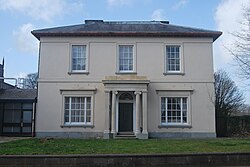Oak House, Monmouth
| Oak House | |
|---|---|
 Oak House, Monmouth | |
 | |
| General information | |
| Address | 6 Monk Street |
| Town or city | Monmouth |
| Country | Wales |
| Coordinates | 51°48′50″N 2°42′47″W / 51.813962°N 2.71296°W |
| Current tenants | British Telecom |
| Completed | 1846 |
| Design and construction | |
| Architect(s) | George Vaughan Maddox |
| Designations | Type II Listed Building, since 15 August 1974 |
Oak House is a Grade II Listed building in Monk Street Monmouth, Wales.
History
The house was designed by George Vaughan Maddox and built in 1846.[1][2]
On the 1881 census the head of Oak House was a George Willis, Magistrate Of Borough & County of Monmouth and a General Practitioner L.R.C.S. M.D. Glasgow. He was born in Ireland in about 1829 and was still occupying the house in the 1891 census listed as a Doctor Of Medicine and Magistrate. He died 15 September 1898. His obituary in The Morning Post newspaper said he had been Mayor of Monmouth three times and was a founder of the Cottage Hospital.[3][4][5] Lloyd Grant Smith another medical practitioner was listed in the 1901 and 1911 Census as head of the household. He was born about 1860 in Birkenhead, Cheshire. Alice Smith was his Wife and was born about 1868. The 1911 census information included the house had thirteen rooms (1911 Census excluding rooms: Scullery, Landing, Lobby, Closet Bathroom, Warehouse, Office and Shop). [6] [7]
The garden and house became home to Monmouth's Telephone Exchange in 1902 when thanks to the intervention of J. A. Rolls the treasury granted money for Monmouth's new telephone exchange.[8] Keith Kissack in his book Monmouth and its Buildings remarking about the telephone exchange said that 'some dreadful buildings replacing the garden'. [1]
Bats
Around 100 Pipistrelle bats were found to be living in the building when engineers went to inspect the building in 2006.[9]
Renovation
Plans were made in 2010 and work was due to start in 2011 to restore the building into a single-family dwelling house including the demolition of the attached redundant modern telephone exchange building by the end of 2012. This includes renovation repair, alterations of the existing listed building to form a four-bedroom house and new building extension of a single-storey service wing and orangey with a two-storey garage/studio. Also the re-instatement of the domestic garden[10][11]
Gallery
-
Monmouth Oak, House and the "dreadful" building that is the Telephone Exchange
-
Oak House Monmouth - Right hand side
-
Oak House - Rear showing the building work to restore the building into a dwelling
Notes
- ^ a b Keith Kissack, Monmouth and its Buildings, Logaston Press, 2003, ISBN 1-904396-01-1, p.59
- ^ "Walking in Monmouth, Monmouthshire and The Wye Valley". The Monmouth Website. Retrieved 1 March 2012.
- ^ Census in the United Kingdom, United States census, 1881; Monmouth, Monmouthshire; page 4, line 4, enumeration district District 2. Retrieved on 1 March 2012.
- ^ Census in the United Kingdom, United States census, 1891; Monmouth, Monmouthshire; page 1, line 1, enumeration district District 2. Retrieved on 1 March 2012.
- ^ "Dr George Willis", The Morning Post (London, England), p. 5, 16 September 1898
- ^ Census in the United Kingdom, United States census, 1911; Monmouth, Monmouthshire; page 1, line 1, enumeration district District 2. Retrieved on 1 March 2012.
- ^ Census in the United Kingdom, United States census, 1901; Monmouth, Monmouthshire; page 40, line 8, enumeration district District 2. Retrieved on 1 March 2012.
- ^ Keith Kissack, Victorian Monmouth, The Monmouth Historical and Educational trust, ISBN 0-9503386-2-1, page 166
- ^ "Bats make telephone exchange home". BBC. Retrieved 1 March 2012.
- ^ "Monmouth Town Council - Planning Committee" (PDF). Monmouth Town Council. 24 May 2010. Archived from the original (PDF) on 4 March 2016. Retrieved 1 March 2012.
- ^ "Monmouth Town Council - Planning Committee" (PDF). Monmouth Town Council. 7 June 2010. Retrieved 1 March 2012.[permanent dead link]



